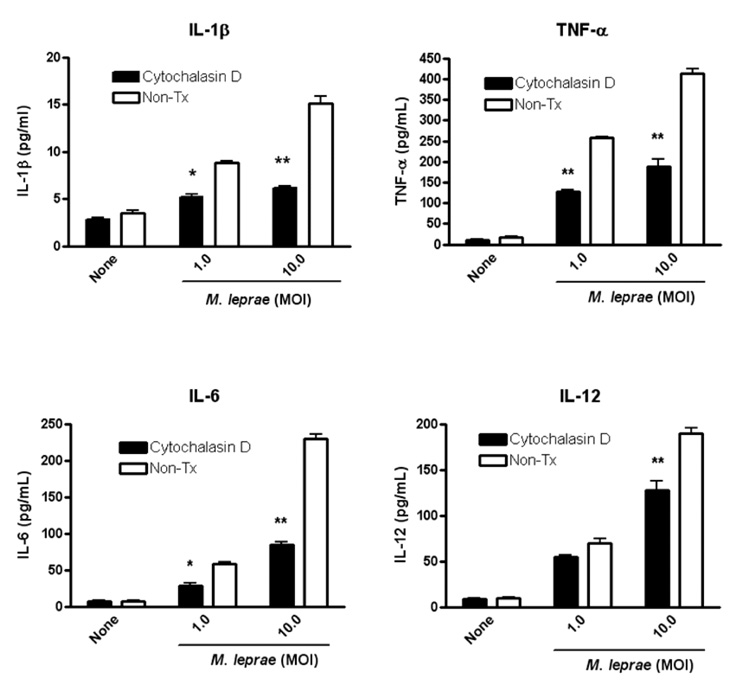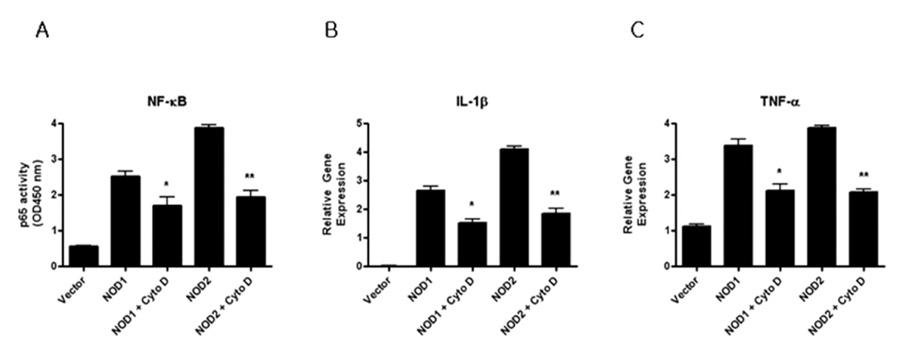Immune Netw.
2011 Dec;11(6):424-427. 10.4110/in.2011.11.6.424.
The Role of Intracellular Receptor NODs for Cytokine Production by Macrophages Infected with Mycobacterium leprae
- Affiliations
-
- 1Institute of Chronic Disease, College of Pharmacy, Sahmyook University, Seoul 139-742, Korea.
- 2Institute of Hansen's Disease, College of Medicine, The Catholic University of Korea, Seoul 137-701, Korea. guetae@catholic.ac.kr
- KMID: 2150731
- DOI: http://doi.org/10.4110/in.2011.11.6.424
Abstract
- The nucleotide-oligomerization domain (NOD) proteins are members of the NOD-like receptor (NLR) family, which are intracellular and cytoplasmic receptors. We analyzed the role of NODs for cytokine production by macrophages infected with intracellular pathogen M. leprae, the causative agent of leprosy. Production of pro-inflammatory cytokines such as IL-1beta and TNF-alpha was inhibited in the presence of cytochalasin D, an agent blocking phagocytosis, suggesting that intracellular signaling was, partially, required for macrophage activation to M. leprae infection. Next, we investigated the role of NOD1 and NOD2 proteins on NF-kappaB activation and cytokine expression. Treatment with M. leprae significantly increased NF-kappaB activation and expression of TNF-alpha and IL-1beta in NOD1- and NOD2-transfected cells. Interestingly, their activation and expression were inhibited by cytochalasin D, suggesting that stimulation of NOD proteins may be associated with the enhancement of cytokine production in host to M. leprae.
Keyword
MeSH Terms
Figure
Reference
-
1. Kang TJ, Lee SB, Chae GT. A polymorphism in the toll-like receptor 2 is associated with IL-12 production from monocyte in lepromatous leprosy. Cytokine. 2002. 20:56–62.
Article2. Kang TJ, Yeum CE, Kim BC, You EY, Chae GT. Differential production of interleukin-10 and interleukin-12 in mononuclear cells from leprosy patients with a Toll-like receptor 2 mutation. Immunology. 2004. 112:674–680.
Article3. Kang TJ, Lee GS, Kim SK, Jin SH, Chae GT. Comparison of two mice strains, A/J and C57BL/6, in caspase-1 activity and IL-1beta secretion of macrophage to Mycobacterium Leprae infection. Mediators Inflamm. 2010. 2010:708713.4. Philpott DJ, Girardin SE. The role of Toll-like receptors and Nod proteins in bacterial infection. Mol Immunol. 2004. 41:1099–1108.
Article5. Franchi L, Park JH, Shaw MH, Marina-Garcia N, Chen G, Kim YG, Núñez G. Intracellular NOD-like receptors in innate immunity, infection and disease. Cell Microbiol. 2008. 10:1–8.
Article6. Kanneganti TD, Lamkanfi M, Núñez G. Intracellular NOD-like receptors in host defense and disease. Immunity. 2007. 27:549–559.
Article7. Kobayashi KS, Chamaillard M, Ogura Y, Henegariu O, Inohara N, Nuñez G, Flavell RA. Nod2-dependent regulation of innate and adaptive immunity in the intestinal tract. Science. 2005. 307:731–734.
Article8. Pauleau AL, Murray PJ. Role of nod2 in the response of macrophages to toll-like receptor agonists. Mol Cell Biol. 2003. 23:7531–7539.
Article9. Girardin SE, Boneca IG, Viala J, Chamaillard M, Labigne A, Thomas G, Philpott DJ, Sansonetti PJ. Nod2 is a general sensor of peptidoglycan through muramyl dipeptide (MDP) detection. J Biol Chem. 2003. 278:8869–8872.
Article10. Inohara N, Ogura Y, Fontalba A, Gutierrez O, Pons F, Crespo J, Fukase K, Inamura S, Kusumoto S, Hashimoto M, Foster SJ, Moran AP, Fernandez-Luna JL, Nuñez G. Host recognition of bacterial muramyl dipeptide mediated through NOD2. Implications for Crohn's disease. J Biol Chem. 2003. 278:5509–5512.11. Coulombe F, Divangahi M, Veyrier F, de Léséleuc L, Gleason JL, Yang Y, Kelliher MA, Pandey AK, Sassetti CM, Reed MB, Behr MA. Increased NOD2-mediated recognition of N-glycolyl muramyl dipeptide. J Exp Med. 2009. 206:1709–1716.
Article12. Ferwerda G, Girardin SE, Kullberg BJ, Le Bourhis L, de Jong DJ, Langenberg DM, van Crevel R, Adema GJ, Ottenhoff TH, Van der Meer JW, Netea MG. NOD2 and toll-like receptors are nonredundant recognition systems of Mycobacterium tuberculosis. PLoS Pathog. 2005. 1:279–285.
Article13. Shepard CC, McRae DH. A method for counting acid-fast bacteria. Int J Lepr Other Mycobact Dis. 1968. 36:78–82.14. Inohara N, del Peso L, Koseki T, Chen S, Núñez G. RICK, a novel protein kinase containing a caspase recruitment domain, interacts with CLARP and regulates CD95-mediated apoptosis. J Biol Chem. 1998. 273:12296–12300.
Article15. Chin AI, Dempsey PW, Bruhn K, Miller JF, Xu Y, Cheng G. Involvement of receptor-interacting protein 2 in innate and adaptive immune responses. Nature. 2002. 416:190–194.
Article16. Kobayashi K, Inohara N, Hernandez LD, Galán JE, Núñez G, Janeway CA, Medzhitov R, Flavell RA. RICK/Rip2/CARDIAK mediates signalling for receptors of the innate and adaptive immune systems. Nature. 2002. 416:194–199.
Article
- Full Text Links
- Actions
-
Cited
- CITED
-
- Close
- Share
- Similar articles
-
- Expression of Nucleotide-oligomerization Domain (NOD) and Related Genes in Mouse Tissues Infected with Mycobacterium leprae
- Effects of Mycobacterium leprae , M . leprae Phenolic Glycolipid - 1 and Cytokines on the Nitric Oxide Generation of RAW 264 . 7 Macrophages
- The role of mycobacterial katG gene in activation of isoniazid
- The association study on infection of Mycobacterium leprae and RIPK2
- Identification of regulatory sequence within the promoter of M.leprae-specific 18-kDa gene and its binding factor(s)



